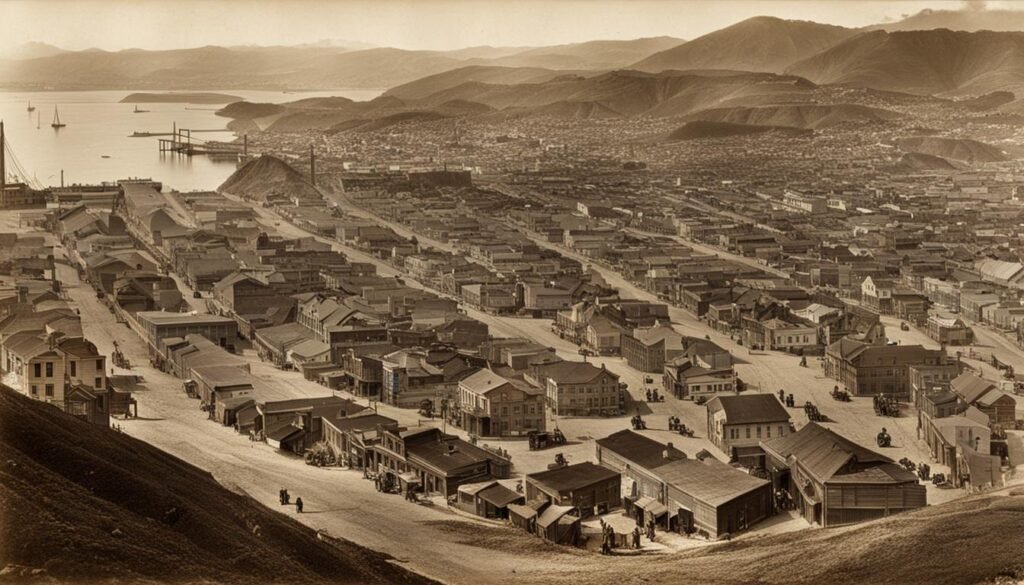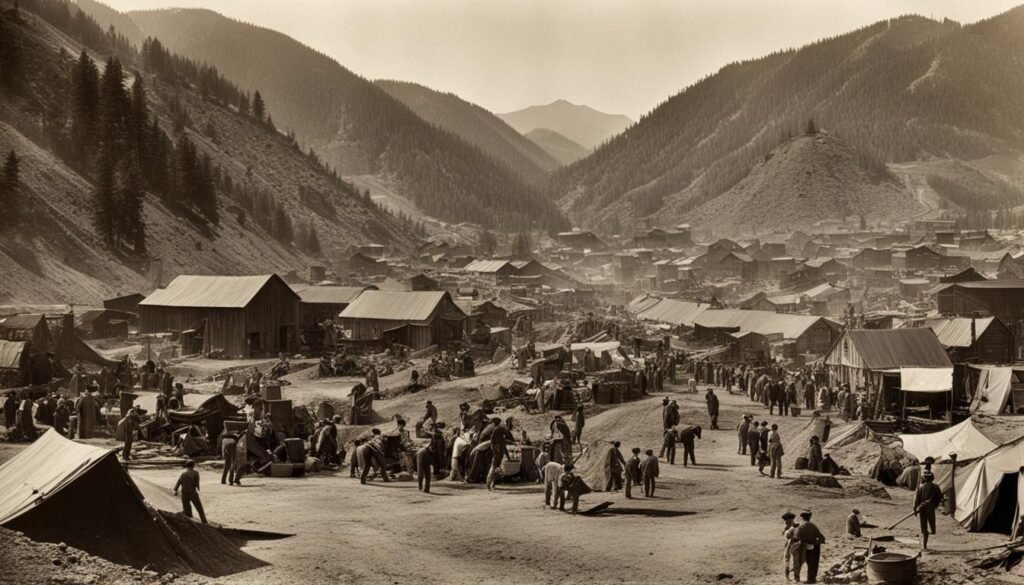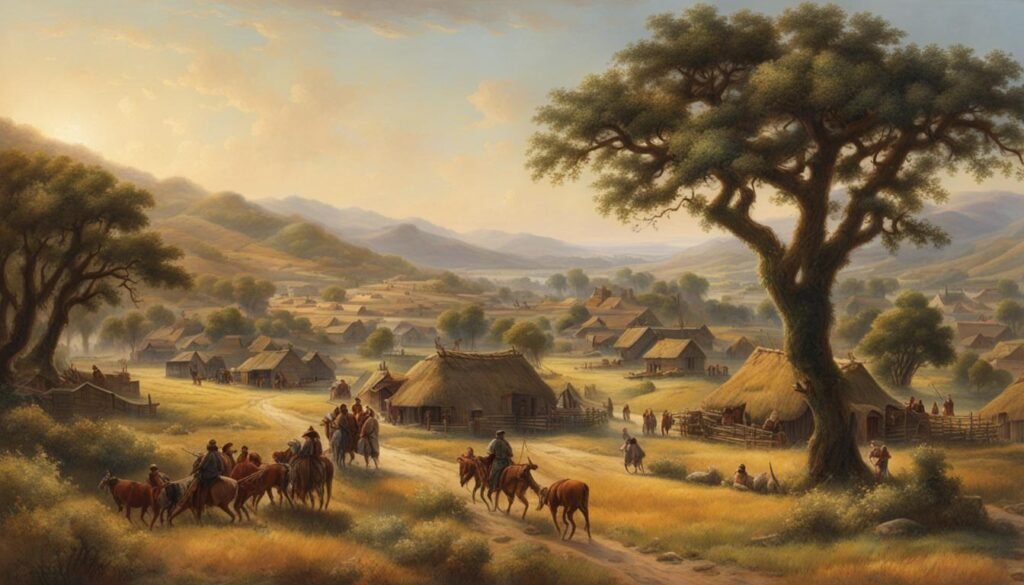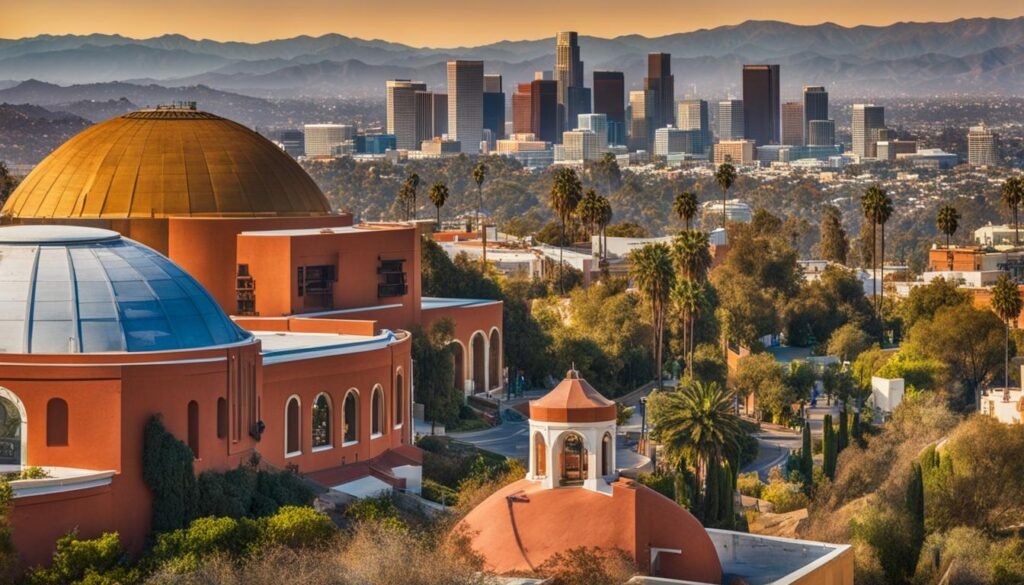California has a captivating history that stretches back centuries. It is a story of exploration, innovation, and resilience. From the early pioneers who ventured westward to the transformative events that shaped the state, California’s history is filled with rich and diverse experiences.
In this article, we will take a journey through time to explore the fascinating historical events and figures that have contributed to the Golden State’s vibrant past. From the discovery of gold to the challenges of statehood, we will uncover the stories that have shaped California into the unique place it is today.
Key Takeaways:
- California has a rich and diverse history, spanning centuries of exploration and settlement.
- The discovery of gold in California in 1848 sparked a massive gold rush and forever changed the region.
- California was part of the Spanish and Mexican territories before becoming a state.
- The California Gold Rush attracted immigrants from around the world and led to rapid population growth.
- The journey to statehood involved drafting a constitution and overcoming political challenges.
The Discovery of Gold
One of the most significant events in California’s history is the discovery of gold in 1848. James W. Marshall found gold at Sutter’s Mill in Coloma, sparking a massive gold rush that attracted hundreds of thousands of people from all over the world. These fortune seekers, known as “forty-niners,” flocked to California in search of wealth and opportunity, forever changing the landscape and economy of the region.
The California Gold Rush was a transformative period that had far-reaching effects on both California and the United States as a whole. The news of the gold discovery spread like wildfire, capturing the imagination of people from all walks of life. Individuals from the eastern states, as well as immigrants from Europe, China, and other parts of the world, traveled to California to join the pursuit of riches.
The gold rush created a frenzied atmosphere as prospectors swarmed the Sierra Nevada foothills, traversing treacherous terrain in search of the precious metal. They faced numerous challenges, including harsh living conditions, lawlessness, and competition for claims. Nonetheless, the allure of striking it rich kept them motivated.
The impact of the gold rush was far-reaching and shaped the narrative of California. It brought rapid population growth, turning small settlements into bustling mining communities virtually overnight. San Francisco, which had been a small village, quickly transformed into a vibrant city and an essential hub for trade and transportation.
The gold rush also led to the development of infrastructure, including the construction of roads, bridges, and waterways to support the influx of people and supplies. It stimulated agriculture and the establishment of businesses, laying the foundation for California’s future economic prosperity.
Moreover, the gold rush had a profound impact on the cultural diversity of California. People from all over the world migrated to the region, bringing with them their languages, customs, and traditions. This multicultural influx contributed to the vibrant and cosmopolitan society that still defines California today.
The discovery of gold in California forever changed the course of history, attracting pioneers and adventurers from far and wide. The pursuit of wealth and opportunity during the gold rush not only altered the landscape of California but also had a lasting impact on the development of the United States. It remains an essential chapter in the rich tapestry of California’s history.
Spanish California
In the early days of California, before the famous gold rush, the region was under the control of the Spanish Empire. It was during the 16th century that Spanish explorers first arrived in what is now known as California, claiming the land for Spain. These explorers established various settlements, including missions, presidios, and pueblos, which played a vital role in Spanish colonization and the Christianization of the indigenous population.
The Spanish missions in California were religious and agricultural outposts designed to spread Christianity and convert the native people to Catholicism. The missions were often situated near fertile land and served as centers of education and production. They were responsible for cultivating crops and raising livestock, helping the Spanish establish a self-sufficient presence in the region.
Alongside the missions, presidios were built to provide military protection for the Spanish settlers. These fortified garrisons served as a defense against potential threats and provided a sense of security for the growing Spanish population in Alta California.
Many of these Spanish settlements, especially the missions, still exist today and have become significant historical and cultural landmarks in California. They stand as a testament to the enduring legacy of Spanish California and the impact that Spanish colonization had on the region.
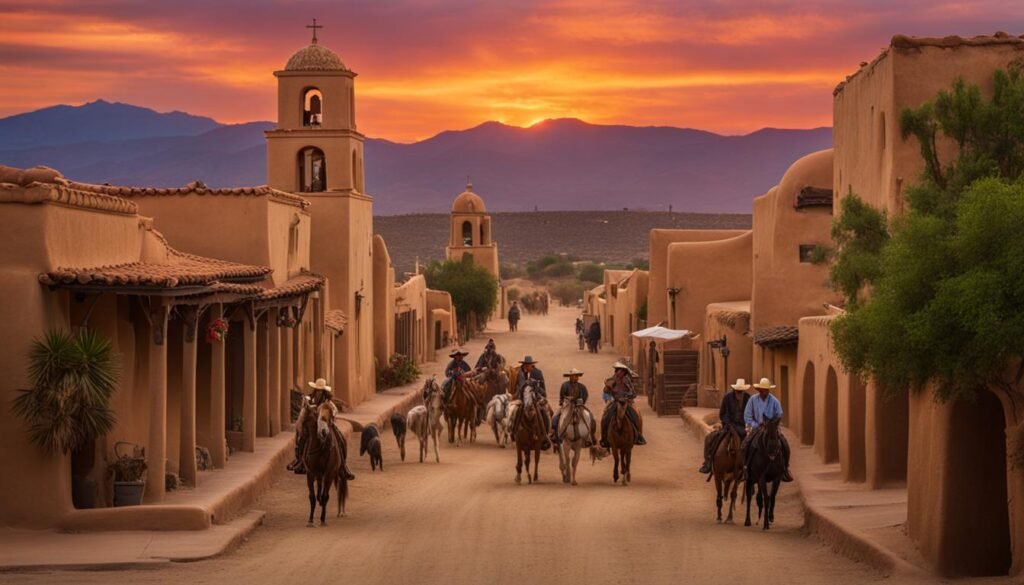
The Legacy of Spanish California
The legacy of Spanish California is deeply intertwined with the history and culture of the state. The missions, presidios, and pueblos established by the Spanish laid the foundation for the development of California. They introduced agriculture, livestock farming, and architectural styles that continue to shape the landscape and character of the region today.
The Spanish influence can be seen in the names of many cities and towns in California, such as San Diego, Los Angeles, and San Francisco, which all have Spanish origins. Even the layout of some cities, with their central plazas and grid patterns, reflects the Spanish colonial design.
Spanish California came to an end in 1821 when Mexico gained independence from Spain. Mexico then assumed control of the territory, marking a new chapter in California’s history. However, the impact of Spanish colonization and the legacy of the missions and presidios would continue to shape the identity of California for centuries to come.
Mexican California
Following Mexico’s independence, California became part of Mexican territory. The Mexican government implemented colonization policies to encourage settlement in California, leading to an influx of Mexican settlers and foreign traders.
Under Mexican rule, efforts were made to establish a presence in California through the establishment of missions, presidios, and pueblos. These settlements aimed to expand Mexican influence and promote agricultural development. The Spanish-speaking population, known as Californios, played a crucial role in the social, economic, and political life of Mexican California.
However, tensions between Mexico and the United States escalated during the mid-19th century. The Mexican government struggled to maintain control over the vast territory of Alta California, and conflicts arose over issues such as land ownership, cultural differences, and the treatment of Native Americans.
This tension eventually culminated in the Mexican-American War, which began in 1846. The war resulted from long-standing disputes between the two nations, with the United States seeking to expand its territory and gain control of California. The war officially ended in 1848 with the signing of the Treaty of Guadalupe Hidalgo.
The Treaty of Guadalupe Hidalgo established the terms of peace and ceded large portions of Mexican territory to the United States. As a result, California officially became part of American territory, marking a significant turning point in its history.
The Impact of Mexican California
- The colonization policies of Mexican California influenced the demographic makeup and cultural heritage of the region.
- The Mexican-American War had significant implications for the future development of California and the United States as a whole.
- The influx of settlers and traders during Mexican rule laid the foundation for California’s multicultural society.
- The establishment of missions and the presence of the Californios contributed to the agricultural and economic development of the region.
California Gold Rush
The California Gold Rush had a profound impact on the development of the state. News of the gold discovery spread rapidly, attracting people from all walks of life to California. Immigrants from the United States, Europe, China, and other parts of the world arrived in search of fortune. The gold rush led to rapid population growth, the rise of mining towns, and the formation of a diverse and multicultural society.
As news of the gold spread, people from all over the world flocked to California in search of their share of the precious metal. These gold rush immigrants, commonly referred to as “forty-niners,” faced immense challenges in their pursuit of wealth. They endured long and treacherous journeys to reach California, facing harsh conditions and unpredictable dangers along the way.
Once in California, these immigrants actively participated in mining activities, contributing to the growth of the mining industry. They established mining camps and towns, where people from different backgrounds and cultures lived side by side. The gold rush created a melting pot of cultures and ideas, shaping the social fabric of California.
Impacts of the Gold Rush
The California Gold Rush not only transformed the cultural landscape of California but also had far-reaching effects on the state’s economy and infrastructure.
- The massive influx of people during the gold rush led to rapid population growth. California’s population swelled from around 14,000 in 1848 to over 223,000 by 1852.
- Mining towns sprung up across the state, providing opportunities for people to settle and create new communities.
- The demand for supplies and services in mining areas stimulated economic growth in other industries such as agriculture, manufacturing, and transportation.
- Infrastructure development boomed, with the construction of roads, bridges, and railroads to support the growing population and facilitate the transportation of goods.
- The gold rush played a significant role in California’s eventual statehood, as the rapid population growth and economic prosperity made it a crucial player in the national political landscape.
The California Gold Rush forever shaped the destiny of the state, leaving a lasting legacy as a symbol of opportunity and adventure. It brought diverse people together and set the stage for California’s future as a land of dreams and possibilities.
California Statehood
As the population of California surged due to the gold rush, the region sought statehood. In 1850, California officially became the 31st state of the United States. The journey to statehood involved the drafting of a state constitution and the resolution of various political and legal challenges.
The admission of California to the union marked a significant milestone in its history. The state’s vibrant and diverse community had played a pivotal role in shaping the future of the nation. With its newly established status, California would continue to thrive and contribute to the growth and development of the United States.
The Drafting of a New Constitution
One of the key steps towards statehood for California was the drafting of a state constitution. The California Constitution was written in 1849 and ratified by the public in 1850. It outlined the fundamental principles and laws that would govern the newly formed state. The constitution reflected the values and aspirations of the people of California, ensuring the protection of individual rights and the establishment of democratic institutions.
Political and Legal Challenges
However, the path to statehood was not without obstacles. There were debates and disputes over issues such as slavery, representation, and the organization of government. The admission of California as a free state upset the balance of power between slave and free states in Congress, intensifying the sectional tensions that would eventually lead to the American Civil War. Nevertheless, with perseverance and compromise, these challenges were overcome, and California was admitted to the union as a free state.
- Resolution of political and legal challenges
- Impact on the balance of power between slave and free states
The admission of California to the union stands as a testament to the resilience and determination of its people. With its statehood secured, California would enter a new era of growth and transformation, becoming one of the most influential and dynamic states in the United States.
Growth and Transformation
After the gold rush, California experienced a period of rapid growth and transformation. The development of the state was marked by significant advancements in agriculture, transportation, and urbanization, laying the groundwork for California’s emergence as a major economic powerhouse.
Agricultural Flourishing
Agriculture and ranching thrived in California’s fertile land, leading to a boom in food production. The state became self-sufficient in producing wheat, with vast fields contributing to a thriving agricultural industry. Farmers capitalized on favorable climate conditions and introduced innovative farming techniques, making California a key player in the nation’s food production.
Urbanization and Transport Expansion
The gold rush facilitated the rapid growth of towns and cities throughout California. As populations soared, urban centers emerged, bustling with activity and contributing to the state’s economic vitality. To support this urbanization, transportation networks expanded, with the construction of railroads connecting California to the rest of the country. These railroads revolutionized trade and facilitated the movement of goods and people, further propelling California’s development.
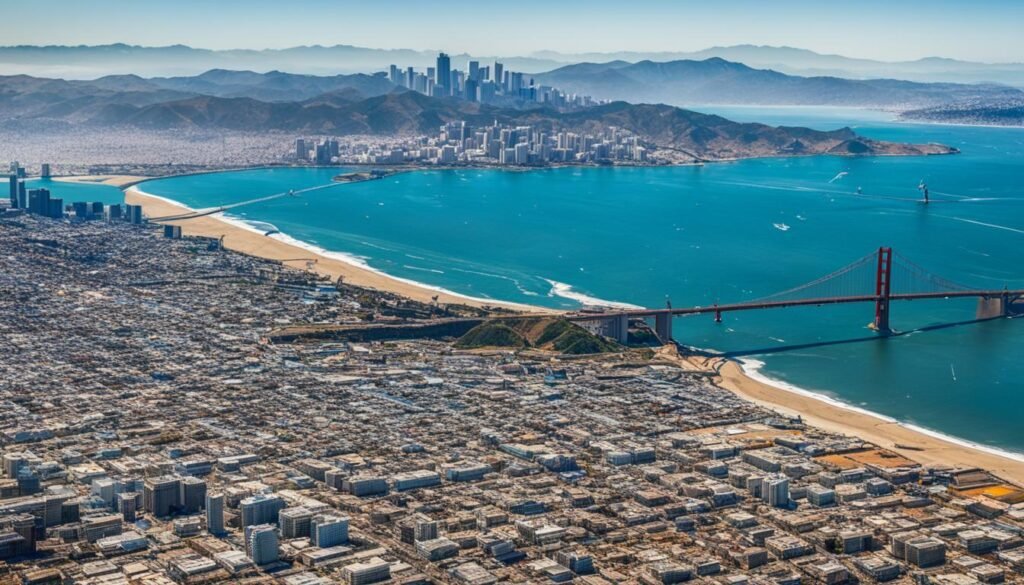
The railways paved the way for increased commerce and facilitated the export of agricultural products to other regions. California’s accessibility and efficient transportation system played a vital role in boosting economic growth and solidifying its position as an influential player in national trade.
Conclusion
California’s captivating history is a timeline filled with remarkable events that have shaped its present-day landscape. From the early colonial days under Spanish rule to the explosive California Gold Rush and its subsequent impact, the state has undergone significant transformations influenced by various cultures and communities.
Exploring the key events in California’s history provides invaluable insights into the journey that has led to the diverse and vibrant state it is today. The Spanish colonization and establishment of missions and presidios laid the foundation for future settlement and development. The discovery of gold in 1848 sparked a frenzy that drew prospectors from all over the world, forever changing California’s economy and population.
California’s journey continued with its official statehood in 1850, solidifying its place as the 31st state of the United States. The subsequent growth and transformation of industries such as agriculture and transportation propelled California into becoming an economic powerhouse. As the state developed, it embraced a rich cultural tapestry woven by people from different backgrounds.
The California history timeline is a testament to the resilience, ingenuity, and determination of the individuals who played a part in shaping this extraordinary state. By understanding the key events in California’s history, we gain a deeper appreciation for its diverse heritage. It is through this understanding that we can better comprehend and celebrate the Golden State’s past, present, and future.
FAQ
What was the California Gold Rush?
The California Gold Rush was a period of mass migration to California in 1848 and 1849, following the discovery of gold at Sutter’s Mill. It attracted hundreds of thousands of people from all over the world who were seeking their fortune in gold.
Who were the forty-niners?
The forty-niners were the people who joined the California Gold Rush in 1849. They were named after the year in which the gold rush peaked.
What was Spanish California?
Spanish California refers to the period when California was part of the Spanish Empire’s colonial holdings. It lasted from the 16th century until 1821, when Mexico gained independence from Spain.
What were missions and presidios in Spanish California?
Missions were religious outposts established by Spanish missionaries to Christianize and colonize the indigenous population. Presidios were military fortresses established for defense purposes.
When was California part of Mexico?
California became part of Mexican territory after Mexico gained independence from Spain in 1821. However, it later became part of the United States after the Mexican-American War.
How did the California Gold Rush impact the state?
The gold rush brought a massive influx of people to California, resulting in rapid population growth, the rise of mining towns, and the development of a multicultural society. It also led to the state’s economic growth and transformation.
When did California become a state?
California became the 31st state of the United States on September 9, 1850. It was admitted to the union following the gold rush and after the drafting of a state constitution.
How did California develop after the gold rush?
After the gold rush, California experienced rapid growth and transformation. Agriculture and ranching flourished, towns and cities were established, and transportation networks expanded, including the construction of railroads.
What are some key events in California’s history?
Some of the key events in California’s history include the Spanish colonization, the California Gold Rush, the admission to the union as a state, and the state’s subsequent growth and development.

